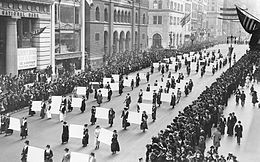
Back تصويت النساء في الولايات المتحدة Arabic যুক্তরাষ্ট্রে নারীদের ভোটাধিকার Bengali/Bangla مافی دەنگدانی ژنان لە ویلایەتە یەکگرتووەکانی ئەمریکا CKB Geschichte des Frauenwahlrechts in den USA German Sufragio femenino en Estados Unidos Spanish Droit de vote des femmes aux États-Unis French 미국의 여성 참정권 Korean د امریکا په متحده ایالاتو کې د مېرمنو د رایې ورکولو حق Pashto/Pushto Sufrágio feminino nos Estados Unidos Portuguese Женское избирательное право в США Russian

| Part of a series on |
| Feminism |
|---|
 |
|
|
Women's suffrage, or the right of women to vote, was established in the United States over the course of the late 19th and early 20th centuries, first in various states and localities, then nationally in 1920 with the ratification of the 19th Amendment to the United States Constitution.[2]
The demand for women's suffrage began to gather strength in the 1840s, emerging from the broader movement for women's rights. In 1848, the Seneca Falls Convention, the first women's rights convention, passed a resolution in favor of women's suffrage despite opposition from some of its organizers, who believed the idea was too extreme.[3] By the time of the first National Women's Rights Convention in 1850, however, suffrage was becoming an increasingly important aspect of the movement's activities.
The first national suffrage organizations were established in 1869 when two competing organizations were formed, one led by Susan B. Anthony and Elizabeth Cady Stanton and the other by Lucy Stone and Frances Ellen Watkins Harper. After years of rivalry, they merged in 1890 as the National American Woman Suffrage Association (NAWSA) with Anthony as its leading force. The Women's Christian Temperance Union (WCTU), which was the largest women's organization at that time, was established in 1873 and also pursued women's suffrage, giving a huge boost to the movement.[4][5]
Hoping that the U.S. Supreme Court would rule that women had a constitutional right to vote, suffragists made several attempts to vote in the early 1870s and then filed lawsuits when they were turned away. Anthony actually succeeded in voting in 1872 but was arrested for that act and found guilty in a widely publicized trial that gave the movement fresh momentum. After the Supreme Court ruled against them in the 1875 case Minor v. Happersett, suffragists began the decades-long campaign for an amendment to the U.S. Constitution that would enfranchise women. Much of the movement's energy, however, went toward working for suffrage on a state-by-state basis. These efforts included pursuing officeholding rights separately in an effort to bolster their argument in favor of voting rights.[3]
The first state to grant women the right to vote had been Wyoming,[6] in 1869, followed by Utah[7] in 1870, Colorado in 1893, Idaho in 1896, Washington[8] in 1910, California[9] in 1911, Oregon[10] and Arizona[11] in 1912, Montana in 1914, North Dakota, New York,[12] and Rhode Island[13] in 1917, Louisiana,[14] Oklahoma,[15] and Michigan[16] in 1918.[17]
In 1916, Alice Paul formed the National Woman's Party (NWP), a group focused on the passage of a national suffrage amendment. Over 200 NWP supporters, the Silent Sentinels, were arrested in 1917 while picketing the White House, some of whom went on hunger strike and endured forced feeding after being sent to prison. Under the leadership of Carrie Chapman Catt, the two-million-member NAWSA also made a national suffrage amendment its top priority. After a hard-fought series of votes in the U.S. Congress and in state legislatures, the Nineteenth Amendment became part of the U.S. Constitution on August 18, 1920.[18] It states, "The right of citizens of the United States to vote shall not be denied or abridged by the United States or by any State on account of sex."
- ^ "Suffragists Parade Down Fifth Avenue – 1917". The New York Times. 1917.
- ^ Temkin, Moshik (January 22, 2024). "Essential Elements for Turning a Cause into a Movement : Lessons from the Suffrage Struggle for Today's Activists". The Commons Social Change Library. Retrieved February 24, 2024.
- ^ a b Katz, Elizabeth D. (July 30, 2021). "Sex, Suffrage, and State Constitutional Law: Women's Legal Right to Hold Public Office". Yale Journal of Law & Feminism. Rochester, NY. SSRN 3896499.
- ^ Marion, Nancy E.; Oliver, Willard M. (2014). Drugs in American Society: An Encyclopedia of History, Politics, Culture, and the Law. ABC-CLIO. p. 963. ISBN 9781610695961.
- ^ Burlingame, Dwight (2004). Philanthropy in America: A Comprehensive Historical Encyclopedia. ABC-CLIO. p. 511. ISBN 9781576078600.
- ^ "Right Choice, Wrong Reasons: Wyoming Women Win the Right to Vote | WyoHistory.org". www.wyohistory.org. Retrieved October 3, 2023.
- ^ "Women's Suffrage in Utah". History to Go. April 29, 2016. Retrieved October 3, 2023.
- ^ "The History of Voting and Elections in Washington State". www2.sos.wa.gov. Retrieved October 3, 2023.
- ^ "History of Women's Suffrage in California :: California Secretary of State". www.sos.ca.gov. Retrieved October 3, 2023.
- ^ "WOMAN SUFFRAGE". Oregon State Capitol Foundation. Retrieved October 3, 2023.
- ^ Brammell, Kasey (July 7, 2020). "How Arizona women won the vote". Arizona PBS. Retrieved October 3, 2023.
- ^ "Recognizing Women's Right to Vote in New York State | New York Heritage". nyheritage.org. Retrieved October 3, 2023.
- ^ "The Struggle for Woman Suffrage in Rhode Island | EnCompass". Retrieved October 3, 2023.
- ^ "Woman Suffrage". 64 Parishes. Retrieved October 3, 2023.
- ^ "Suffrage Amendment | The Encyclopedia of Oklahoma History and Culture". Oklahoma Historical Society | OHS. Retrieved October 3, 2023.
- ^ "Michigan and the 19th Amendment (U.S. National Park Service)". www.nps.gov. Retrieved October 3, 2023.
- ^ "Timeline and Map of Woman Suffrage Legislation". Mapping American Social Movements Project. University of Washington. Retrieved September 25, 2022.
- ^ "The 19th Amendment". National Archives. May 16, 2019. Retrieved May 31, 2019.